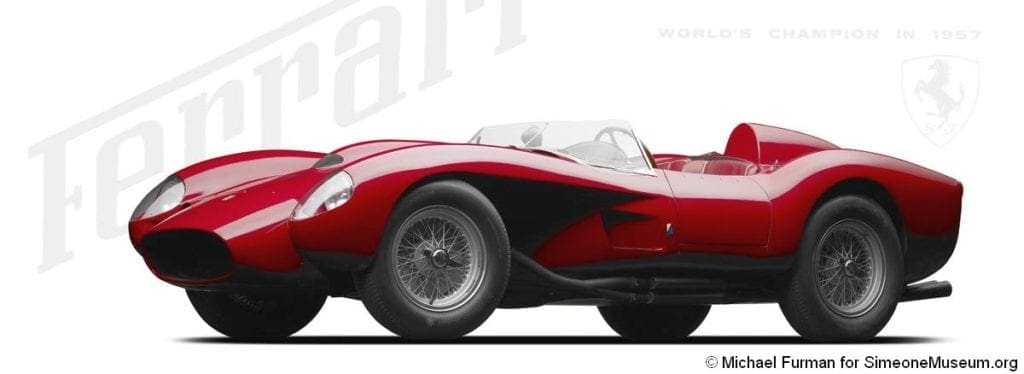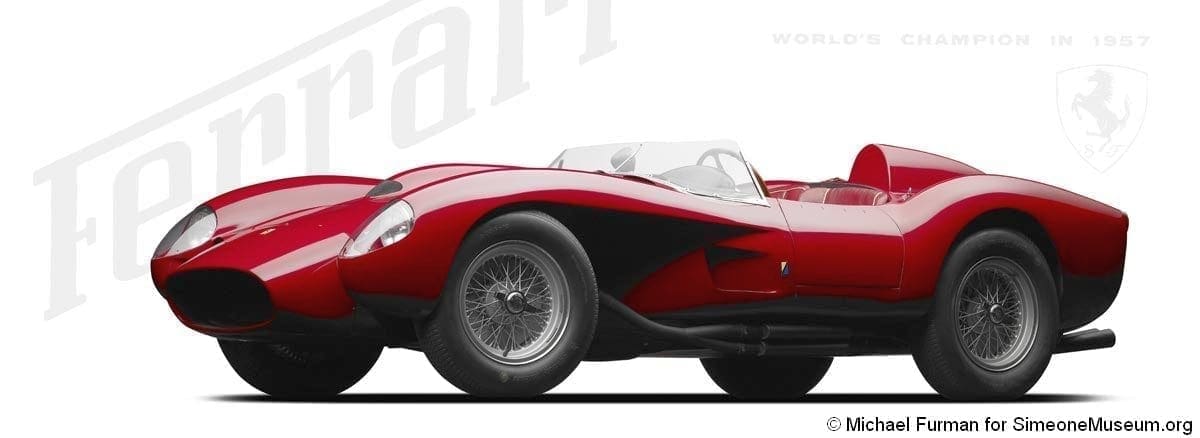This “red head” has extensive racing history in the USA. I acquired it in the late 1980s after being heavily sought-after for many years.
THESE CARS
They determined it that the reliability of the 250 V-12 engine was superior to the other choices available to Ferrari for the 1958 season. The new
Finally, in November 1957, the all new 250 Testa Rossa was revealed at the highly publicized and much photographed press conference. They gained further publicity through the motoring press, most notably Auto Italiana Sport who not only showed detailed photos of our actual car, the first customer car, but even a nice shot of it going up the ramp into the belly of a plane at the Malpensa Airport on its way to New York, and ultimately to dealer Johnny von Neumann in California.
They beefed the chassis up; the first cars had drum brakes, while large capacity sports races were veering towards discs. The live rear axle persisted. But the beautiful Scaglietti pontoon bodywork made the car, then and now, an immediate visual standout. With the cutaway fenders providing ample air cooling for the brakes the car had a remarkable history in international and regional sports racing, going through several iterations until the more stable De Dion rear axle all-enveloping bodies evolved in 1960 and ’61.
The striking bodywork makes them one of the most desired post-war sports racing cars. In total, 22 models of the Testa Rossa entered 19 international championship races between 1958 and 1961, winning in 10.
Generically, the Testa Rossa’s built for the World Sportscar Championship progressively modified throughout the seasons. In 1958 victories included Sebring, Targa Florio, and Le Mans with the greatest race drivers on the planet. Privateers added further cars to the field so that Ferrari’s were supernumerary in the big races. Ferrari’s greatest disappointment in 1958 was a loss at Nurburgring to our Aston Martin DBR1. These cars had a long and interesting history and although only 19 were available in 1958 for sale to customers, their successes in club racing continued well into the 1960s. They made a few works cars for 1959 to 1961, all with impressive racing records.
OUR CAR
After the November 22, 1957 press conference, the car was in John von Neumann’s hands by November 25. Unlike any other pontoon fender Testa Rossa, the nosepiece was detachable. The door hinges were invisible inside and the brake drums had angled cooling fins. von Neumann was the Hollywood, California Ferrari distributor and his service manager was Richie Ginther who took on the driving responsibility in the major races.
After some sorting out during race week in Nassau, Ginther changed the car somewhat to make it more driver friendly. On January 26, 1958 it competed in the Argentina 1000 but its solid performance was destroyed with a failed ring and pinion. At Sebring on March 22 the pinion failed during the 11th hour of the 12 hour race when the car was sitting in 3rd position. Subsequently, the car had a robust racing career on the West Coast driven by Ginther, von Neumann and his adopted daughter Josie.
By the fall of 1959 apparently von Neumann was interested in getting rid of all of his racing Ferrari’s and Jack Nethercutt, who wanted TR59 #0768, was actually sold four other relatively new Ferrari race cars as well which included our 0710. After passing through a series of owners, of which extensive photographs are available throughout its 1960s career, it was acquired by Joel Finn from racing guru Steve Earle.
They cover his detailed restoration of the car in “The Prancing Horse, #47”. His “ace restorer,” Larry Taylor, began an extensive refurbishment in June 1973. The restoration was “intended not only to result in the finest Testa Rossa in existence, but to be as mechanically, bodily, and authentically perfect as possible.” The car also had to be track worthy. The only disappointment is that not all of 0710 engine could be used so, besides parts from 0710, there were also contributions by engine 0722 and 0758. But he fulfilled his goal. He finished it in red old-fashioned nitrocellulose lacquer and this excellent paint job survives today in fine condition, over three decades after they applied it.
Flash forward to 1988. My desire for an original pontoon-fendered Testa Rossa was unabated. Most of the few cars that were available had new bodies. Most times someone changed the engines. Joel Finn’s Testa Rossa V-12 published in 1979 outlines, car-by-car, the history of this model which includes the many engines changes, new bodies, and a few disappearances. Prior to my being able to acquire 0710, I sent Joel to São Paulo to look at a Drogo bodied Testa Rossa which he felt was too far from the original to fit my collecting interest and I had to agree, since none of our cars have been totally re-bodied.
It turns out that Finn was interested in buying a special car which required huge sums of money. Living in nearby Long Island City, car fancier Virgil Millet apparently provided the source of funds for this purchase. Joel had to give up, besides his prized Testa Rossa, a wonderful little Maserati A6GCS, and parts of two Maserati 450S cars. I’m not sure what else, was involved in the Finn/Millet deal.
When I heard that this car was in Millet’s farm in Riegelsville, Pennsylvania, I had to see it, and my interest was immediately obvious to Virgil. I rarely expose my personal feelings and find that cars will come your way if you express a patient interest. This, however, was not the case here. And rather than being rebuffed Virgil felt sensitive to the interest. He soon constructed a trade deal because he loved Bentleys, Rolls Royce, and early American brass cars, several of which were housed in barns on his farm. He initially wanted a supercharged Bentley, a Speed Six Bentley, and an 8-liter Bentley.
Interestingly, Virgil was not interested in original coachwork as long as the chassis and engine were correct and the appearance of the body was authentic. I already had a Speed Six Bentley with a replica Van Den Plas body which was never a keeper but an early purchase, in chassis form, which I had to develop just to enjoy. I had some pleasant moments in this unrestored car including a frightening 85 MPH ride with fearless car buff extraordinaire John Bentley. So that took care of the Speed Six.
I could not find an 8-liter with an open body, but I convinced Virgil that the Speed Six was a far better sporting car than the 8-liter and why not a Speed Six in Le Mans trim? I found another Speed Six chassis and took it to David George to have a Le Mans type “recreation” (an odious metaphor) to suit Virgil. This he did under the watchful and often critical eye of Mr. Millet who would appear periodically to Dave’s shop in Frazer, Pennsylvania to inspect, criticize, and mainly add to the work order.
The last bit was a problem.
Time had gone by and my coffers were not as substantial. It turns out, however, that venture capitalist Tom Perkins, who had assembled the wonderful collection of supercharged sports cars had decided that he wanted to live on a fabulous boat which he was constructing, and therefore had no need for his collection. He had a very nice supercharged Bentley Le Mans replica on a correct chassis with the obligatory boy racer body. I did not quite have the funds to buy this car, Serial Number MS3942, but Virgil agreed to split Tom’s asking price and the car was ours.
As David was finishing the second of the Speed Sixes, and ready to undertake fettling at Virgil’s discretion of the blower, the deal was getting close to finality. Near the end Virgil felt he should have just one more car to sweeten the deal. He looked around my shop and saw the 1926 8-75 Kissel Speedster I had restored in Dad’s honor but not quite to Virgil’s standards. He wanted to throw that in and also have David get it in proper “show condition” which required new upholstery, new paint, and all the things needed to meet his satisfaction.
We completed the expensive lagniappe and by early 1989 the grand swap was ready to happen. I still recall the excitement of the day when we went to pick up the Testa Rossa from his farm, tow it home, and finally put it in place with its racing kith. The car has performed perfectly since we’ve gained it. It always starts on the button and has had essentially no mechanical work necessary to keep it in fine running condition. Years later we retrieved the faithful Kissel from a Christie’s auction. I also swapped an old Rolls Royce to Virgil for Finn’s lovely Maserati A6 GCS but the little Maser went to fund the Cobra Daytona adventure.


A true great, and now one of the world’s most sought after Ferraris.
Topgear.com
















